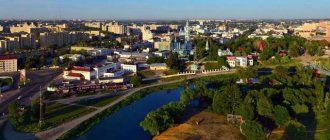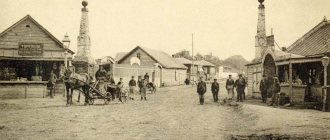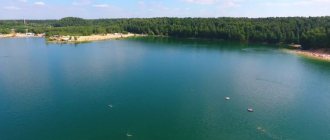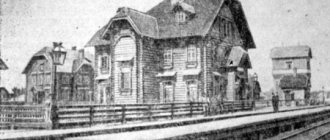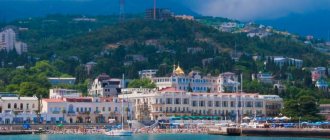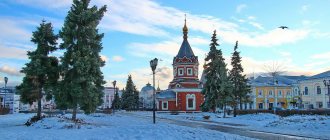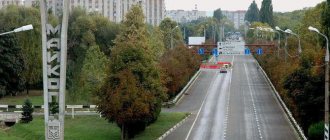The question of where Tambov is located will confuse some people, although the name of the city is well known to every Russian. The city, which has preserved its originality, historical memory, is clean, surrounded by flowers, is considered the most environmentally friendly city in Russia. They call it provincial, but is that a minus in our time? No, that's a big plus.
What region is Tambov?
Tambov Region
lies in the southern part of the East European Plain, in the central part of the Oka-Don Plain. ...
| Tambov Region | |
| A country | Russia |
| Included in | Central Federal District Central Chernozem Economic Region |
| Regional center | Tambov |
| Head of Administration | Alexander Valerievich Nikitin |
Work and salary in Tambov in 2021
Vast industrial zones, where there are plants, factories and industrial enterprises, warehouses, auto repair shops, wholesale depots, and various repair services, are located in the east and west of Tambov.
Next to them is the private sector, where workers of enterprises and factories live.
Major employers in Tambov are:
- , “TambovPolymerMash”, “Pigment”, “Electropribor”, “Komsomolets”, “Tambov Oktyabr Plant” and others;
- shopping centers;
- hypermarkets “Auchan”, “Magnit”, “Ogonyok”, “Pyaterochka”;
- BC "Gallery";
- “Tambov Bacon” – a complex for processing and production of meat products;
- confectionery;
- bakeries;
- liquor;
- Dairy Family Farms;
- distributive
People with certain qualifications can get hired at enterprises. Representatives of blue-collar professions earn a lot, but such professions are not popular among young people.
Rating of popular industries in Tambov by number of vacancies
Old factories that have long been closed are being renovated and turned into shopping centers and hypermarkets. For example, for building materials you need to go to Stroydepo, and for food, drinks, clothes, and household goods - to Auchan and Festival Park.
Many residents of the suburbs and Tambov find work in local markets:
- Tambov central market;
- "Cold";
- "Southeastern";
- wholesale centers located on Ippodromnaya and Bastionnaya streets.
The situation on the labor market is significantly influenced by shopping centers, where cashiers, salespeople, security guards, production workers, leaflet distributors, sales agents, managers and administrators are always needed.
Only working in a shopping center has certain disadvantages:
- irregular working hours;
- unpaid night shifts;
- work on holidays and weekends;
- sometimes lack of social package and paid leave.
Thus, there are enough vacancies in Tambov for unskilled workers. Often people without education are hired into warehouses, wholesale centers, and processing plants.
Many people who move to Tambov for permanent residence try to open their own business in the city.
To do this, you need to overcome bureaucratic difficulties, including correctly filling out documents for the company at the tax office, registering the enterprise in order to legally carry out your work activities.
The average salary in Tambov in 2022 varies from 33 thousand to 35 thousand. Although the job advertisement indicates salaries in the amount of 45 thousand–70 thousand rubles per month, in fact, employees of various enterprises, factories, warehouses receive much less.
Find out on our website: average salaries in Russian cities in 2022.
Due to low official incomes, city residents have to work two or three jobs to pay for the apartment, buy food, and educate their children. The bulk of the population is employed in blue-collar jobs, retail trade, and the service sector.
What are the residents of the city of Tambov called?
“Tambov residents” or “Tambov residents”: only one name for the residents
regional center
Residents of Tambov are called by
the incorrect word “Tambovites”.
Interesting materials:
How to open EML format on Android? How to open fb2 format on android? How to open fb2 format? How to open iso format? How to open mdf format? How to open NEF format? How to open pptx format? How to open WMA format on Mac? How to open MPEG video? How to scan a document in text format?
Story
| Founded as a fortress near the crossing on the Tsna River opposite the mouth of the Tambov River. However, this location turned out to be inconvenient, and the city was built 20 miles down the Tsna River. In 1647, a system of fortifications was built near the city - the Tambov Wall, which became part of the Belgorod abatis line . In the middle of the 18th century. Tambov is losing its significance as a military fortress and is developing as the center of an agricultural region. The period of its intensive development occurred in the 18th-19th centuries. From 1719 - the center of the Tambov province (as part of the Azov, from 1732 Voronezh province), from 1780 - the Tambov governorship (from 1796 - the Tambov province). Since 1796 - the center of the Tambov province. By the end of the 19th century. Tambov was the largest center of grain trade; enterprises for processing agricultural products and small metalworking factories developed there. Since 1934 the city belongs to the Voronezh region, and since 1937 - the center of the Tambov region. | Tambov. Kazan Cathedral (1791). |
Administrative-territorial structure and local self-government[edit | edit code]
Territorial organization of local self-government[edit | edit code]
In the Tambov region there are 352 municipalities, of which 7 urban districts, 23 municipal districts, 8 cities, 13 urban settlements, 309 rural settlements.
1750 rural settlements.
Urban districts
Administrative division of the Tambov region.
- City of Kirsanov (I)
- City of Kotovsk (II)
- City of Michurinsk (III)
- City of Morshansk (IV)
- City of Rasskazovo (V)
- City of Tambov (VI)
- City of Uvarovo (VII)
Municipal districts
- Bondarsky district (village Bondari)
- Gavrilovsky district (village Gavrilovka 2nd)
- Zherdevsky district (Zherdevka)
- Znamensky district (township Znamenka)
- Inzhavinsky district (town Inzhavino)
- Kirsanovsky district (Kirsanov city)
- Michurinsky district (Michurinsk)
- Mordovian district (urban village Mordovo)
- Morshansky district (Morshansk)
- Muchkapsky district (muchkapsky town)
- Nikiforovsky district (Dmitrievka town)
- Pervomaisky district (township Pervomaisky)
- Petrovsky district (Petrovskoye village)
- Pichaevsky district (Pichaevo village)
- Rasskazovsky district (Rasskazovo)
- Rzhaksa district (urban village Rzhaksa)
- Sampur district (Satinka village)
- Sosnovsky district (settlement Sosnovka)
- Staroyurievsky district (Staroyurievsky village)
- Tambov district (Tambov)
- Tokarevsky district (town Tokarevka)
- Uvarovsky district (Uvarovo)
- Umet district (urban town Umet)
Cities of the Tambov region[edit | edit code]
Coat of arms of the Tambov region
Cities of the Tambov region
Administrative center: Tambov
Perch | Kirsanov | Kotovsk | Michurinsk | Morshansk | Rasskazovo | Uvarovo
Populated areas of the Tambov region[edit | edit code]
| Settlements with a population of more than 5 thousand as of January 1, 2005 | |||||||||||||||||||||||||||||||||||||||||
|
Tambov. Century XIX
It was at this time that Tambov declared itself as the breadbasket of Russia. The city hosted annual fairs (Tenth and Kazan), which attracted merchants from all over central Russia. Tambov bread was sold abroad. The city was built up with good-quality houses and public buildings: a cadet corps, a noble assembly, a city society, a craft council, a public library, and an institute for noble maidens.
In 1824, the first gymnasium opened, and a year later the first paved street appeared. A hospital and an almshouse, 3 hotels, 7 taverns, clothing stores, and grocery stores were built. There were two monasteries and many churches in the city, which even now give the city a unique flavor and tranquility.
Content
- 1 Geography
- 2 History
- 3 Administrative-territorial structure and local government 3.1 Territorial organization of local government
- 3.2 Cities of the Tambov region
- 3.3 Settlements of the Tambov region
History[edit | edit code]
Coat of arms of the Tambov province
About one and a half thousand years ago, tribes of the Mordovian-Moksha ethnic group lived on the territory of the present Tambov region.
The final settlement of the Tambov region by Russians occurred in the 17th century. To protect the southern borders from Tatar raids and for the further development of the Black Earth Region, the Russian government built the fortified cities of Kozlov (1635) and Tambov (1636).
As an independent administrative unit, the Tambov region was separated from the Central Black Earth Region on September 27, 1937.
Science and culture
Tambov. Main building of Tambov State Technical University | Scientific, educational and cultural institutions : Research Institute of Chemicals for Polymer Materials, Research Institute of Organic Intermediates and Dyes, All-Russian Research Institute of Rubber Engineering. Tambov State University, Tambov State Technical University, Tambov Military Aviation Engineering Institute, Tambov State Music and Pedagogical Institute named after. S.V. Rachmaninov. |
Branches: Military University of Radiation, Chemical and Biological Protection, Institute of Entrepreneurship Infrastructure, Moscow New Law Institute. Drama and puppet theaters. Philharmonic. Museums: local history, history of medicine, museum-estate of the Chicherins. Art Gallery.
| Among the most notable architectural structures of the city are the Intercession Church (1763-1769) with a hipped bell tower, the Kazan Church (1791), and the former Bishop's House (1791), preserved on the territory of the former Kazan Monastery (17th century). Other architectural monuments of Tambov include the building of the main post office on Cathedral Square (1786), Gostiny Dvor (1836-1837), an orphanage (first half of the 19th century), a real school (second half of the 19th century, now a secondary school), the Assembly of the Nobility ( 1897), Naryshkin reading room (1892), Suvorov’s house (early 19th century), Protasyev’s house (1830s), Aseev’s house (1903-1906). |
Power[edit | edit code]
The governor of the region is Oleg Ivanovich Betin. He was first appointed to this post in 1995, but lost to the communist Alexander Ryabov in December. In December 1999, he won the gubernatorial elections in the second round, and confirmed his powers at the next elections in December 2003.
On December 18, 2005, elections to the regional Duma took place. 25 seats were distributed according to party lists and another 25 - in single-mandate constituencies.
United Russia received 40.52% of the votes on party lists and 15 out of 25 seats in single-mandate constituencies (28-29 out of 50 seats in total).
The seven percent barrier was also overcome by:
- Communist Party of the Russian Federation (19.95% - 9-10 seats)
- LDPR (9.7% - 3-4 seats)
The following also received seats in single-member constituencies:
- Rodina - 2 places
- APR - 2 places
- independent - 4 seats.
Population[edit | edit code]
According to the results of the 2010 All-Russian Population Census[1], the population of the region is 1,092,396 people. Population density is 31.7 people/km².
The population is almost mono-national: the majority are Russian.
| People | Number of people in 2002, thousand () |
| Russians | 1136,9 |
| Ukrainians | 10,8 |
| Armenians | 4,3 |
| Gypsies | 3,0 |
| Tatars | 2,7 |
| Belarusians | 2,4 |
| Azerbaijanis | 2,3 |
| Germans | 1,1 |
| Yazidis | 1,0 |
| nations with a population of more than 1000 people are shown |
Belgorod line
Belgorod Line , a defensive line on the southern border of the Russian state in the 17th century.
Separate fortresses of the future feature were built at the end of the 16th century (Voronezh, Belgorod). In the 1630s. in connection with the increasing danger from the Crimean Khanate, the old abatis line was renewed across the Oka River and fortresses of the Belgorod line were built along the routes of the most frequent raids of the Crimean Tatars: along the Nogai road (Kozlov, Tambov, Verkhniy and Nizhny Lomov), Kalmiussky and Izyumsky roads (Userd , Yablonov, Korocha). In the early 1640s. 18 more fortified cities were built and two fortified areas were created with a system of forts, ramparts, ditches, located in the Komaritsa volost near Sevsk and in Lebedyansky districts. By the end of the 1640s. the construction of the Belgorod line was basically completed.
In the cities of the Belgorod region there were more than 10 thousand service people. The line ran from Tambov to Akhtyrka. In 1648-1654 the defensive line from Nizhny Lomov was extended to Simbirsk. The Belgorod line made it difficult for the Crimean Tatars to raid the Russian state and contributed to the economic development of the black soil lands of the South. With the advance of Russia's borders to the south, the Belgorod Line lost its significance by the end of the 17th century.
History of education
The city of Tambov is relatively young. The date of its formation is considered to be 1636. At this time, on a hill located at the confluence of the Tsna and Studenets rivers, where Tambov is currently located, a fortress was founded that protected the borders of Russia from raids by the Nogais and Crimean Tatars. It was no coincidence that the fortress was located in the Wild Field area. It was a practically uninhabited territory, without any borders, where settlers from Russia went.
The construction of the fortress was led by governor Roman Boborykin. The location chosen for construction was excellent; it seemed that nature itself was protecting the structure from uninvited guests. A ditch was dug from the side of the rivers, which rested its ends against them, from where water flowed into it. Six-meter-high walls made of oak logs were built on three unprotected sides. The fortress garrison numbered up to 1000 people.
